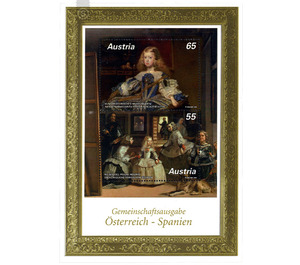Infanta Margarita Teresa by Diego Velázquez - Austria / II. Republic of Austria 2009
Theme: Art & Culture
| Country | Austria / II. Republic of Austria |
| Issue Date | 2009 |
| Edition Issued | 250,000 |
| Item Type | Block |
| Chronological Chapter | OOS-OE2 |
| Chronological Issue Number | Block 56 |
| SID | 46240 |
| In 53 Wishlists | |
Margarita Teresa's parents were King Philip IV of Spain and Maria Anna of Austria. Her marriage to her uncle and cousin Leopold I was long negotiated and planned. On this occasion, the Madrid court sent three paintings by Diego Velázquez to Vienna, showing the little Infanta at the age of three, five and eight years. In 1666, the 15-year-old bride arrived in Vienna and the wedding was celebrated with much splendor. Shortly after the birth of her sixth child, the young Empress Margarita Teresa died in Vienna at the age of just 21. Leopold I founded his claim to Spain with this marriage later in the Spanish War of Succession. Diego Rodríguez de Silva y Velázquez was born in 1599 in Seville, one of the spiritual and cultural centers of the country. He began early an apprenticeship with the painter Francisco Herrera. then in the workshop of Francisco Pacheco. In 1618, Velázquez married his daughter and began to work as an independent artist. 1622 Velázquez went to Madrid, where he was given the opportunity to paint the 17-year-old Philip IV. In 1623 Velázquez entered the service of the Spanish king as court painter. Among the four court painters Velázquez was able to acquire the clear primacy over time. An encounter with Rubens sparked in Velázquez the desire to see in Italy the works of great Italian painters. From 1629 to 1631 he traveled to Italy to make copies of for the Spanish court. During his stay, works inspired by Italian masters emerged. After his return to Madrid, he created countless works thanks to his efficient workshop, in which his son-in-law also worked. He was also the embodiment of many buildings of the king transferred. The specialties of Velázquez were the equestrian pictures and, in addition to the portraits of the dynasty, the dwarves and dwarves, whom he painted with the same sensitivity. In late 1648 Velázquez went back to Italy on behalf of the king to acquire works of art for a new art academy. Returning to Madrid in 1651, the second marriage of the Spanish king to Maria Anna of Austria necessitated his activities as court painter. Velázquez, one of the greatest portrait painters of all time, died on August 6, 1660 in Madrid. The two stamps of this joint issue with Spain: Museo del Prado, Madrid: The royal family of Felipe IV Kunsthistorisches Museum Vienna: Infanta Margarita Teresa in blue dress.


